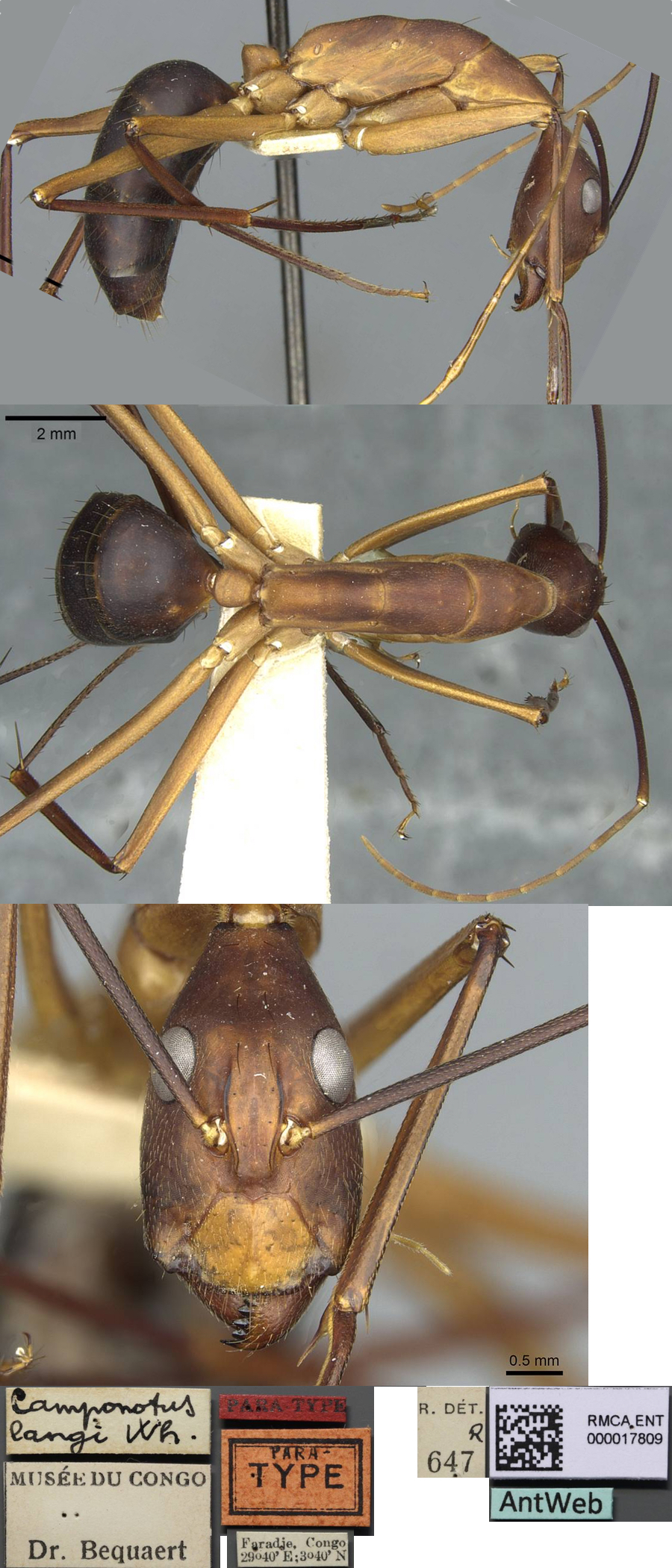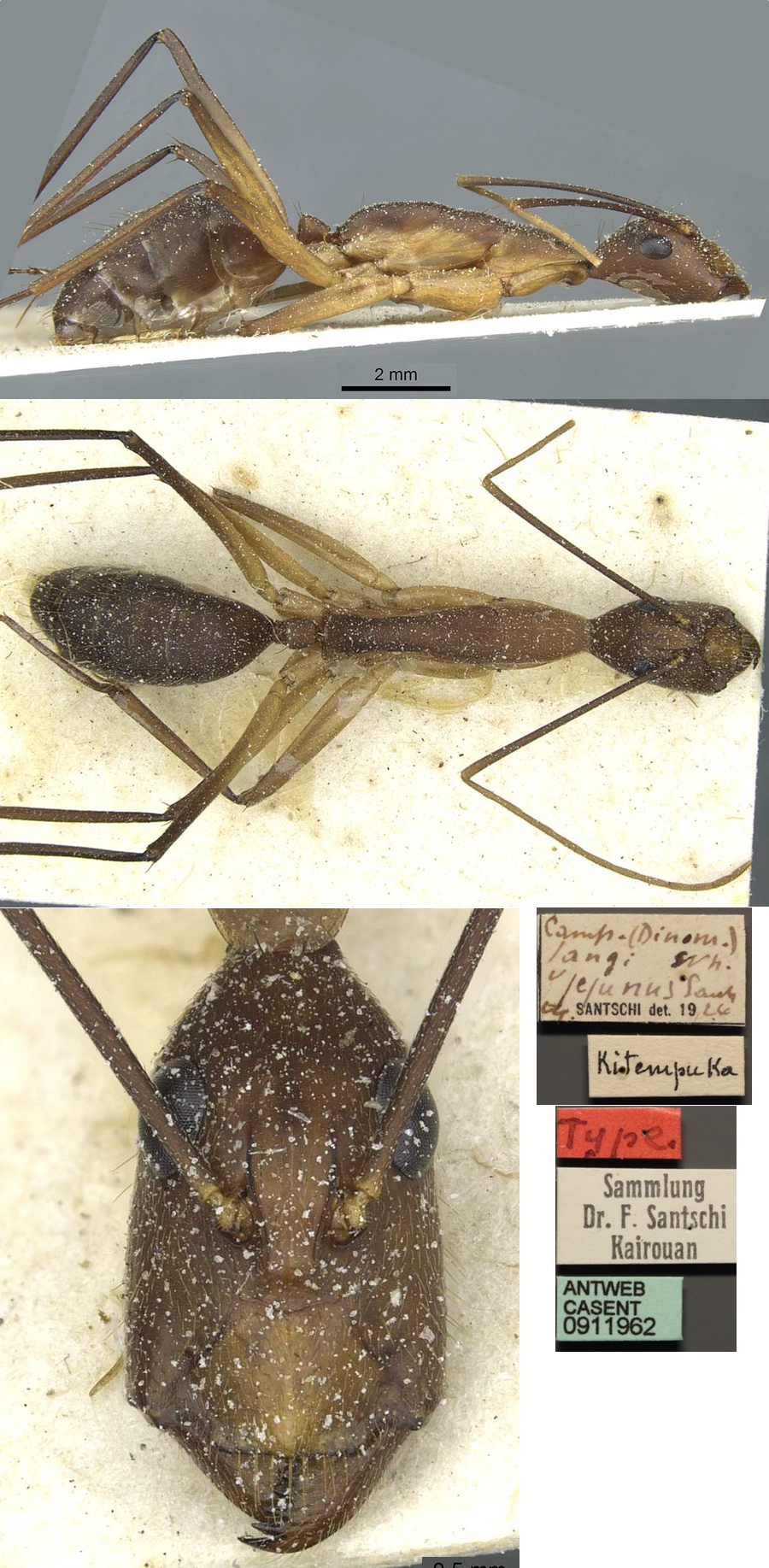Camponotus (Tanaemyrmex) langi Wheeler
  Type location Zaïre
(Camponotus (Dinomyrmex) langi,
new species, Wheeler, 1922: 241, illustrated, all forms) Type location Zaïre
(Camponotus (Dinomyrmex) langi,
new species, Wheeler, 1922: 241, illustrated, all forms)
subspecies jejunus
(Camponotus (Tanemyrmex) langi
Wheeler v. jejunus n. var.,
Santschi, 1926b: 254, worker) from Zaïre. Kirempuka, Bondroit -
see below
all
forms described (see Bolton, 1995)  . .
|
 Wheeler's
description (1922) was - Wheeler's
description (1922) was -
MAJOR WORKER - TL 12.5 to 14 mm. Head unusually small, decidedly longer
than broad (4.1 X 3 mm, without the mandibles), slightly narrower in
front than behind, with broadly and not deeply excised posterior border
and evenly, feebly convex sides. Eyes rather small and elongate,
situated twice their length from the posterior border of the head.
Mandibles rather small, convex, with 7 short teeth, Clypeus carinate,
its anterior border emarginate on each side, the median lobe very
short, its border coarsely crenulate, its corners obtuse. Frontal area
small, subtriangular; frontal carinae closely approximated, especially
in front. Antennae long (4.5 mm) and slender, not enlarged distally,
their bases distinctly flattened but not dilated, reaching nearly half
their length beyond the posterior border of the head; funiculi long,
filiform. Thorax low and narrow; metanotum distinct; propodeum long,
its base nearly four times the length of the declivity, with a
distinct, transverse impression in the middle. Petiole very low,
subquadrate, and as broad as long when seen from above, in profile
scarcely higher than long, obliquely truncated anteriorly and
posteriorly, with very blunt superior border. Gaster long and narrow.
Legs very long and thin; tibiae triangular in cross-section, deeply
channelled on all three surfaces, their flexor borders without row of
bristles.
Mandibles, clypeus, legs, sides of thorax, and sides and venter of
gaster somewhat shining, remainder of the body opaque. Mandibles more
opaque at the base, where they are densely shagreened, smooth and
coarsely punctate in the middle, coarsely striated towards the tip.
Clypeus, head, and thorax very densely shagreened, the head more
distinctly; clypeus, cheeks, and sides of head with small, scattered
shallow, piligerous punctures. Gaster very finely and transversely
shagreened,with very sparse piligerous punctures.
Hairs and pubescence golden yellow, very sparse and short, more
abundant on the gula and top of the head, very short, sparse, and
appressed on the appendages. Sides of head with short, sparse, stiff
hairs. Pubescence very dilute, distinct on the gaster and all parts of
the head, longest on the gula. Head and gaster deep castaneous;
mandibles dark red, with black borders; clypeus and adjacent portions
of cheeks often reddish; tips and insertions of antennal scapes, palpi,
thorax, petiole, trochanters, and femora dull brownish yellow; upper
surface of pronotum, mesonotum, and base of propodeum dark brown with
paler sutures; tibiae, femora, and tarsi dark brown, the latter
somewhat paler at their tips; posterior borders of gastric segments
rather broadly yellowish and shining.
|
MINOR
WORKER - TL 11 to 12 mm. Head very long (3.4 mm, without the mandibles)
compared with its width (1.9 mm), the portion in front of the eyes
nearly as broad as long, a little broader in front, with straight
sides; behind the eyes it narrows rapidly into a neck with concave
sides, the occipital border being somewhat less than one-third of the
anterior border. Eyes prominent, situated more than twice their length
from the occipital border. Clypeus resembling that of the maxima.
Antennae longer, the scapes not flattened, straight, reaching fully
three-fifths of their length beyond the occipital border. Thorax and
petiole as in major but lower, and the transverse impression on the
base of the propodeum scarcely indicated. Sculpture much finer,
pilosity and pubescence even sparser than in the maxima. Color paler;
clypeus, cheeks, funiculi, petiole, ventral portions of thorax, coxae,
and femora yellow; mandibles, scapes, posterior portion of head,
tibiae, and dorsal surface of thorax and gaster brown.
FEMALE (dealated) - TL 21 mm. Head large, slightly
longer than broad, broader behind than in front, with straight sides
and feebly and broadly excised posterior border. Mandibles more convex
than in the maxima, clypeus very similar. Antennal scapes very slightly
flattened at the base, extending nearly one-third their length beyond
the posterior corners of the head. Thorax through the wing-insertions
not broader than the head; mesonotum as long as broad. Petiole much
higher than in the worker, nearly twice as high as long, elliptical
from behind, its anterior and posterior surfaces convex, its border
narrowed above and slightly notched in the middle, in profile rather
acute. Mandibles shining, coarsely punctate, their bases opaque. Head
and body more shining than in the maxima, but similarly sculptured.
Pilosity like that of the maxima but the pubescence very long and
abundant on the prosterna, fore coxae, and lower portions of the
metapleurae; as long but sparser on the gula and posterior surfaces of
the head; short on the scapes, but longer and oblique towards their
tips. Tibiae and tarsi with short, stiff, oblique hairs. Head black;
mandibles, sutures of thorax, upper portions of mesopleurae, and pro-
and mesonotum, scutellum, and gaster castaneous; remainder of thorax,
petiole, middle and hind coxae, and trochanters yellowish red. Legs
castaneous, tips of tarsi paler.
MALE - TL 13 mm. Head twice as long as broad, the
portion in front of the eyes long, with subparallel, slightly concave
cheeks, the posterior portion rapidly narrowed to the occiput, the
sides and occipital border nearly straight. Eyes convex, at the middle
of the sides of the head. Mandibles spatulate, bluntly pointed,
edentate but with overlapping tips. Clypeus carinate, without an
anterior lobe, its border broadly rounded. Antennae very long and
slender. Thorax and gaster long and narrow; propodeum elongate, evenly
convex, sloping, without distinct base and declivity. Petiole much as
in the minor worker. Legs very long. Mandibles, head, thorax, and legs
rather opaque; propodeum, petiole, and gaster shining, punctuation
feeble and inconspicuous. Hairs yellow, short, and sparse as in the
worker minima. Brownish yellow; head, mesonotum, scutellum, tibiae, and
tarsi brown; mandibles darker. Wings distinctly yellow, with yellowish
brown veins and dark brown pterostigma.
Described from forty-one workers from Faradje (type
locality), a female and worker minima from Garamba, and two males from
Faradje (Lang and Chapin). The following note accompanies the specimens
from Faradje: "These long-legged ants are very fond of sugar or
anything sweet, such as fruits, etc. They are seldom seen during the
daytime. The colony had made its nest between boxes that were piled up
on the verandah of a house, and the ants were assembled in a hollow
space about half an inch wide. A few fibrous particles of detritus were
used in the construction of the nest." There are no data accompanying
the two specimens from Garamba, so that I am not certain that the
female is cospecific with the worker. C. langi is very peculiar
in the small, narrow head of the maxima and the long neck-like
occipital region of the minima. There can be no doubt that what I have
described as the maxima is really the largest worker form. Fifteen
specimens of the series all agree in the shape and size of the head as
represented in the figure; the remaining specimens are all minimae.
Mediae, apparently, do not exist.
|
 The photomontage
of
a paratype minor worker is collated from http://www.antweb.org/specimen.do?name=rmcaent000017809. The photomontage
of
a paratype minor worker is collated from http://www.antweb.org/specimen.do?name=rmcaent000017809.
|
 The photomontage
of
the jejunus type minor worker is collated from http://www.antweb.org/specimen.do?name=casent0911962. The photomontage
of
the jejunus type minor worker is collated from http://www.antweb.org/specimen.do?name=casent0911962.
Santschi's (1926b) description of jejunus is at  . .
|
|
Camponotus (Tanaemyrmex) langi |
Central African Republic
P Annoyer
FN
|
10.ii.2005
Dzanga-Sangha
02°50’01.8" N
16°08’13.7" E |
Camp 3; U.V : 18h-3h,
dans petite saline à proximité du camp;
375m asl |
2
|
|
Camponotus (Tanaemyrmex) langi |
Central African Republic
P Annoyer
Camp 1G
|
14-14.x.2008
Dzanga-Sangha
03°03'58.3" N
16°08'59.6" E |
Camp 1; 528 m;
Piege au salée posé sur le sol
|
1
|
Camponotus (Tanaemyrmex) langi
media & minor |
Central African Republic
P Annoyer
PCO3
|
25.xi.2010
Dzanga-Sangha
2°28'49.5"N
16°12'55.9"E
|
392 m; pitfall/dung trap,
Lake 1 base |
2
|
|
 The photomontage is of a minor worker from CAR, Pannoyer PCO3 The photomontage is of a minor worker from CAR, Pannoyer PCO3
|
|